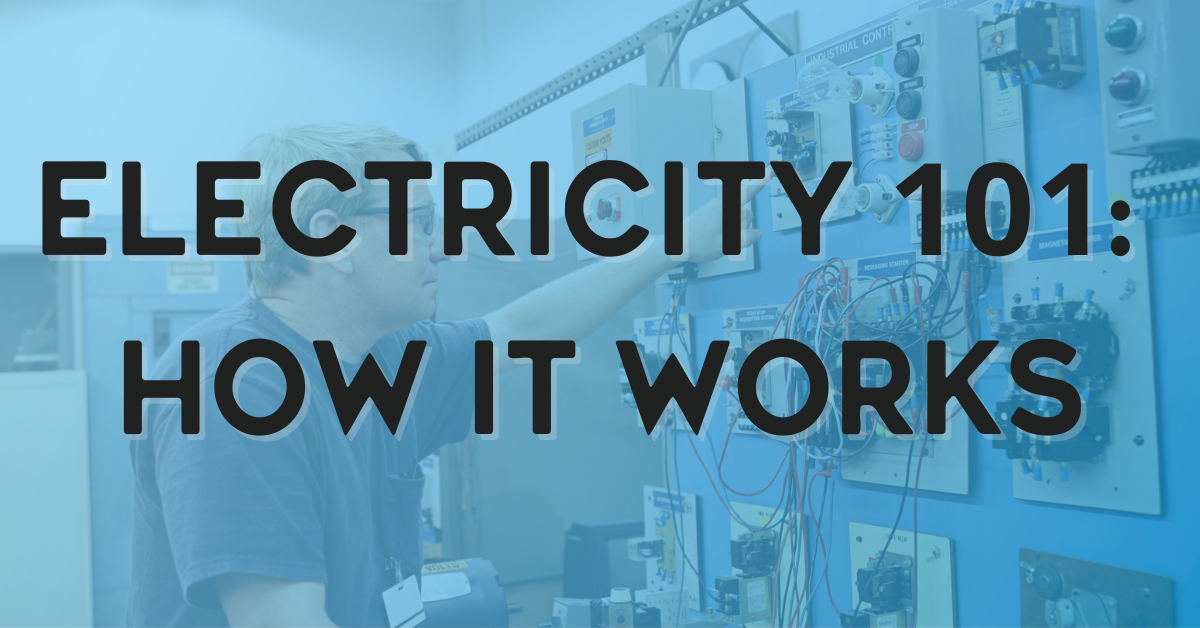
To operate safely around electrical wiring and installations, it’s important to understand how electricity works and how it flows through circuits, bringing power to commercial and industrial equipment.
Electricity is a form of energy, which can be generated by several methods, including hydroelectric dams, coal-fired steam plants, and chemical batteries. No matter how it is created, electricity then flows through conducting circuits, where it powers pumps, motors, mixers, and more.
Like water through a pipe
You can think of electricity as something like water moving through a pipe. In the pipe, water always flows from a point of high pressure at the pump, to a point of lower pressure at the end of the pipe.
Metal wires are electrical “conductors” because they contain electrons that can easily separate from their original atoms and freely move throughout the material. Like the water in a pipe, these electrons flow from an area of high electrical pressure to lower electrical pressure. The difference between these two pressures is called the “potential difference,” or voltage, and is measured in volts.
Going to ground
As the electrons flow, they always seek any available path to an area of lower pressure, completing a “circuit.” In the simplest type of electrical circuit, electrons flow from an electrical source, with a voltage of 120 V, through an appliance, such as a lamp or motor, then back to the electrical source to make a complete path. . As the electrons move, they provide the energy to operate the device.
The total number of electrons flowing in a wire is called the “electric current,” and is measured in amperes, or amps. The size of the current can be compared to the diameter of a water pipe, which controls how much water can flow through it. A thicker wire carries more current.
Resistors and insulators
As the current flows through the circuit, it encounters resistance, some from the wire itself, as well as from a light bulb, motor, or other load wired into the circuit. Resistance can be compared to friction of water flowing through a narrow section of pipe, which slows down the flow. Resistance is controlled by the inherent material properties of the conductor and the loads, and is measured in ohms.
When a resistor is placed into an electric circuit, the electrons traveling through the circuit try to move through it, but instead, many of them collide into the resistor’s atoms. Each collision converts the kinetic or electrical energy into heat and glowing light.
Some materials, such as glass and ceramic, are so resistant to electron flow that they don’t allow any electric current through. These materials are called insulators, and they can be used to enclose and protect a “hot” electrical wire to prevent dangerous electrical shorts.
Alternating Current (AC)
The simple circuit described above operated on a direct current (DC) scheme, in which the current always flowing in one direction. But most electrical circuits in a building run on an alternating current (AC) scheme.
AC electricity is generated at a power plant using a giant magnet, which oscillates so that the electrons in a wire change direction very quickly. This causes the voltage in a circuit change very quickly from zero to the maximum and then back to zero.
In an AC scheme, the electrons flow in one direction, then quickly stop and flow in the opposite direction. This happens over and over, at the rate of 60 times a second (in the U.S.) so the electrical current coming out of the wall is usually 120-volt, 60-cycle AC.
Electrical power distribution grid
Because of the relationship between power, voltage and current, large electrical wires running long distances from a power plant carrying the high currents needed to bring enough power a city can’t run on a DC scheme. That might require a wire the diameter of a subway tunnel, which would be very expensive and impractical, and would also lose too much power and create large amounts of heat as a result of inefficiency.
To solve this problem, the AC voltage produced at the power plant goes to a transmission substation where it is “stepped up” through a transformer, reaching up to 1 million volts. This current is transmitted along high voltage wires kept away from danger on tall metal pylons. These high voltage lines travel cross-country, feeding into power substations just outside the cities and towns where the electricity is to be distributed.
In the substation, the high voltage current is “stepped down” to a lower voltage, around 12,000 volts AC, with a transformer. From there, it is split off and distributed in several directions through wires strung on electric utility poles or buried under ground until it reaches another small transformer which steps the electricity down once again to 120 volts AC before it enters a building.
Understanding the basics is just the first step in proper electrical training.
Interested in learning more? Check out our Basic Electricity for the Non-Electrician seminar.






Comments
Nice post! I appreciate the sincere efforts you have made in writing the article. Recommend others also. Great job and keep up the good work!
Aaron Lal | 13.03.19